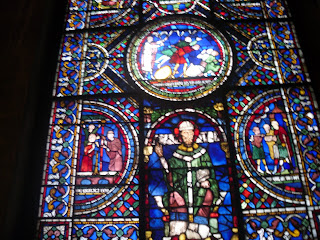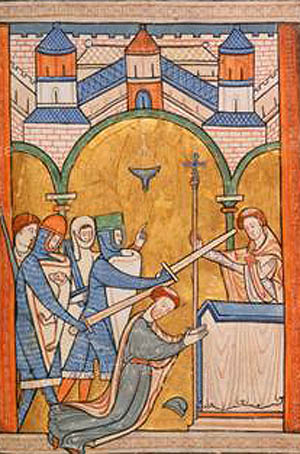As my blog’s purpose is now complete, the time to reflect on how and what I researched affected myself and my eventual outcome has come.
I knew straight away I was going to look at Thomas Becket for this independent project; I knew about him but had never had the opportunity to study him. I began my project like everyone begins theirs – with basic fact. My early development was fine and originally, I was going to compare texts and images. More than anything though, I found this boring. This was a large problem as it shows in my work and I was only able to fix this with a tutor’s suggestion that I compare art.
I adore art on a personal level; I have completed an A Level in it and am forever doodling on random scraps of paper – this search for art was fruitful, interesting and fun. Neither in History or Art A Levels have I actually had to start research without a known artist, and for a small period of time, I was stuck on this. So rather than a person, I took my main source to be Canterbury Cathedral’s windows. Windows led to drawings which led to Pilgrim’s souvenirs, which led to Chasses. I think this has improved my research skills greatly – prior to this, I had been told where to look for ideas. Supporting literature was actually easier to find than the primary art sources as many of them are aged or completely destroyed today. At the start of my course, we were given ‘Module Learning Outcomes’ and one of those was ‘Become skilled in the analysis of visual and textual sources, and the variety of methods…’ It was the use of ‘methods’ that really helped my understanding; I found learning about how to make enamel incredibly interesting as it would have been such a long process in the 12th Century – and the detail is impeccable.
My preconceived ideas about this project, I have learnt, were wrong. I did not expect to become quite so attached to this topic; it’s riveting and has actually made me enjoy the medieval period far more than any previous projects – usually I prefer politics or modern history. I was also expecting at least one of my peers to have studied Becket in their education. I was very wrong about that and have developed my independent study skills.
My topic did not go to ‘plan’ at all. but I actually feel that’s a positive thing. If it had, I probably would not have felt quite so passionate or interested in it – I am now even considering volunteering at Canterbury over a holiday period in the coming year. I feel I have learnt a lot about my approach to a project and research. Presentation is also far more vital in history now; before rows of neat typing was acceptable, but with the virtual world taking over, you have to consider every aspect. This is why I used so many of my own images on my blog – it is too easy to go onto Google Images and lose any originality.
I have really enjoyed this project and I am quite disappointed that it is finished now – hopefully I will be able to revisit Becket in my later University career!
Bibliography:
Ainsworth, W.H. Ainsworth’s Magazine: a Miscellany of Romance, General Literature and Art. Vol, 1 (1842) 171
Biggs, D. Michalove, S.D. Compton Reeves, A. Reputation and representation in fifteenth century Europe. Brill, 2004
Bisson, L.M. Chaucer and the Late Medieval World. St Martin’s Press 1998
Brainerd Slocum, K. Liturgies in honour of Thomas Becket. University of Toronto Press, 2004
Breck, J. A Reliquary of Saint Thomas Becket Made for John of Salisbury. The Metropolitan Museum of Art Bulletin, Vol.13, No. 10 (1918) 220-224
Building News and Architectural Review, Vol. 9
Butler, J. The Quest for Becket’s Bones. Yale University Press, 1995
Cantor, N.F. In the Wake of the Plague. Simon and Schuster, 2001
Chaucer, G. The Canterbury Tales. Penguin Revised Ed, 1951 (Originally published 1400)
Jameson, A. Legends of the Monastic Orders: as Represented in the Fine Arts. Forming the Second Series of Sacred and Legendary Art. Longmans, Green and Co. 1867
Michaels. M.A Stained Glass of Canterbury Cathedral. Scala Publishers Ltd; illustrated edition edition 1999.
Morris, C, Roberts, P. Pilgrimage: the English experience from Becket to Bunyan. Cambridge University Press, 2002
Phillips, S. Edward II. Yale University Press, 2010
Shoham-Steiner, E. Jews and Healing at Medieval Saints’ Shrines: Participation, Polemics and Shared Cultures. The Harvard Theological Review, Vol. 103, No. 1 (2010) 111-129
Smart, N. The World's Religions, Cambridge University Press, 1998
Thomas, K. Religion and the Decline of Magic. Penguin, 1973
Wilson, C. The Gothic Cathedral. Thames and Hudson, 1990
Woolf, D.R. The social circulation of the past: English historical culture, 1500-1730 Oxford University Press, 2003
Various Authors - Dictionary of World History. Oxford University Press, 2006.
Various: Art and Architecture of Late Medieval Pilgrimage in Northern Europe and the British Isles - Volume 2, Brill 2004
























